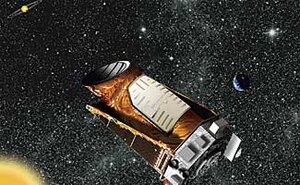Kepler passes first test - ready to hunt for other Earths
By gauging the subtle differences in light given off by a planet 1,000 light-years away, it shows that it's up to the job.

The Kepler Mission is in search of Earth-like planets in the habitable zones.
Nasa
NASA's planet-hunting Kepler spacecraft has passed its first "spot that planet" test, detecting a giant Jupiter-like orb hurtling around a star roughly 1,000 light-years away.
The test run clearly demonstrates that Kepler will have little trouble performing its primary mission: detecting Earth-like planets in the habitable zones of sun-like stars.
In the process, Kepler has given astronomers a detailed look at the planet – its temperature and how its atmosphere operates.
The results "are stunning indeed," says Alan Boss, an astronomer who specializes in the birth and evolution of solar systems at the Carnegie Institution for Science in Washington, D.C.
The Kepler team was confident that their spacecraft would be able to achieve its main goal. But nothing substitutes for checking the observatory out on orbit to be sure.
"We now know that Kepler can do it," Dr. Boss said during a briefing Thursday afternoon at NASA headquarters. "The question that remains is: How many Earths are out there for Kepler to find?"
Scientists have become adept at finding planets by measuring how starlight dims when planets pass in front of their suns – an occurrence called a transit. But that method has favored finding large planets that can dim the light of their star significantly. To see Earth-size planets, Kepler must be able to detect much more subtle changes – which is what it demonstrated in its study of the large planet dubbed HAT-P-7b.
Kepler did see transits, but it also gauged the overall amount of light from HAT-P-7b's solar system and noticed that the light dimmed when the planet slipped behind the star. In other words, it could tell that the relatively small amount of light given off by the planet had disappeared.
Detecting that dip constituted proof that Kepler is sensitive enough to find Earth-like planets, says William Boruki, the lead scientist on the Kepler mission.
In its planet hunt, Kepler will measure changes in starlight for some 100,000 individuals stars simultaneously.
HAT-P-7b was discovered by ground-based telescopes in 2008. It has about twice Jupiter's mass. It's roughly 1.4 times as large as Jupiter. It orbits its star at a distance of less than 4 million miles. So it whips around it's parent star in 2.2 Earth days.
Kepler scientists selected HAT-P-7b as one planet for analysis during the telescope's shake-down period because the research team that discovered the planet predicted that Kepler should be able to spot intriguing features in the solar system's light, says Dimitar Sasselov, a researcher at the Harvard-Smithsonian Center for Astrophysics and a member of the team that first detected the planet.
And so it did. The rise and fall of the solar system's light when the planet was passing behind and then reemerging on the other side of the star has allowed astronomers to tease out some intriguing details about HAT-P-7b.
The Kepler team, which formally reports its results in tomorrow's issue of the journal Science, estimates that the planet's temperature is a searing 5,000 degrees Fahrenheit. So it's trapping an enormous amount of eat from the star.
Indeed, the star is so hot that the light Kepler is picking up from HAT-P-7b is not just reflected starlight, it's also light coming directly from the planet itself, according to Sara Seager, a specialist on such so-called exoplanets at the Massachusetts Institute of Technology in Cambridge, Mass. That implies an atmosphere with a high-altitude layer of elements that excel in absorbing heat – perhaps titanium oxide, or sulfur-based hazes.
The high contrast between the planet's brightest and dimmest phases – it's night half and day half – suggests that its atmosphere does a very poor job of circulating heat around the planet, she says.
Although Kepler's main target is Earth-like planets, when it comes to the amount of data Kepler also will provide on this and other transiting planets it detects, "this is just the tip of the iceberg," Dr. Seager says.
-----
Follow us on Twitter.
